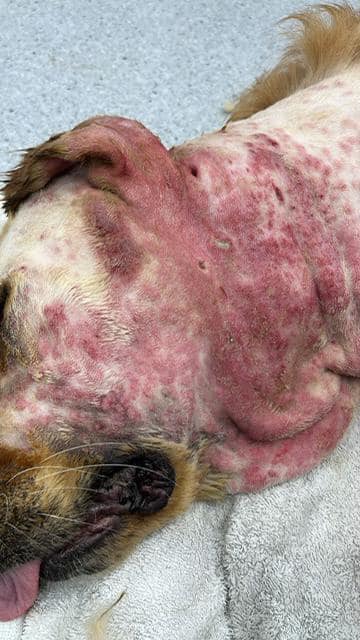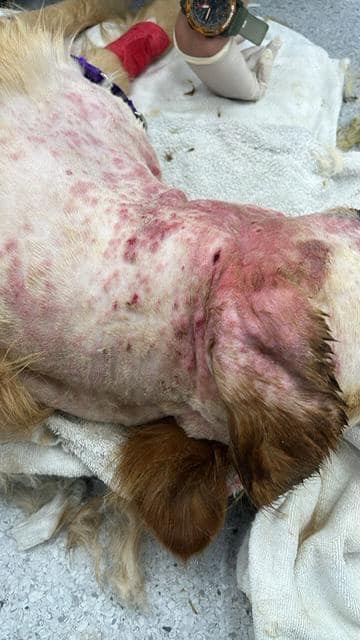Would you torture your best friend?
No, right?
Similarly, dogs are Man’s best friend, so it’s common sense to take the greatest care of them.
Turns out common sense isn’t that common, and there are still some who let animal abuse slide.
Pet Trainer Accused of Abusing Dog
A dog is seen in a few viral photos online with a serious red marring on its neck. Actually, calling it serious is an understatement. Here, see it for yourself:


Many accused the person responsible, a dog trainer, of animal abuse. The trainer supposedly used shock collars and prong collars on the innocent pup, and many suspected it caused the extreme reaction.
For those who don’t know, a shock collar, or electronic collar, electrocutes the dog’s neck when a button is pressed to get the dog to behave.
As for the prong collar, it is a ring with metal protrusions (or prongs) on the inside that poke against the dog’s neck. It tightens around the dog’s neck when the dog pulls, thus exerting more pressure on the neck.

For reference, here’s what a prong collar looks like

Sharp-eyed readers would notice puncture marks on the dog’s neck, signs that it’s possibly because of the prong collar’s use.
Responding to the boatload of criticisms, the trainer said the dog had an allergy to the nickel in the collars, and the injuries were not because of the use of the collars themselves.
Adding on, she explained that nickel allergies were common in dogs, and this was just a more severe case.
If the news takes you aback and you’re wondering how this whole hullabaloo exploded in the first place, fret not.
The Backstory
The story begins when a pet owner, let’s call her A, gets her first puppy, let’s call it B.
B, a golden retriever, was playful and eager by nature. As he grew and grew, his massive size and weight, coupled with his hyperactivity, made him increasingly difficult to control.
Precisely, he weighed around 35 kilos.
Soon enough, he outgrew his playpen, learned to open that gate that contained him, and started teething, among other destructive behaviours.
Outside the home, B pulled and lunged towards everything – people, birds, other dogs, etc. With his sheer power, it became apparent that A wasn’t going to be able to continue caring for him.
At one point, she even considered putting him up for adoption after trying other methods, like boarding and daycare.
That was where she met a dog trainer, let’s call her C.
C recommended for B to be put in a board-and-train (B&T) program and introduced the usage of certain tools on him, such as an electric shock collar.
After some discussion, A decided to put her dog in C’s care for three weeks, during which C would provide the dog’s owner regular updates on her furball.
Three weeks later, when A collected B from C, she noticed significant improvements in the dog’s behaviour, especially when she brought him out on walks.
Satisfied with the results, A decided to enlist C’s help again, this time for 10 days, because she was travelling overseas.
Little did she know that was her undoing.
Finding Out
Two days before returning, A received a call from C regarding her dog. Over the phone, C told A that the dog was suffering from some allergies but didn’t mention the severity of them.
C also mentioned that the dog was scratching itself more than usual, to which A asked if there was an infection. The trainer told her no.
Unknowingly, A assumed the dog was in stable condition and didn’t think much about it.
Because she was infected with COVID-19 after her holiday, A couldn’t pick the dog up herself and had a friend pick it up for her.
When her friend went to fetch B home, she was shocked.
To her utter horror, she found B dirty with his fur matted. Disgustingly, the wounds on his neck were infected, foul-smelling and overflowing with pus.
Immediately, A’s friend rushed the dog to a 24-hour vet to seek treatment. The doctor couldn’t specify the cause of the skin condition but suggested that the injuries could be caused by certain tools used on the pet.
When C volunteered to help shave the dog and clean up the wound, A rejected the offer and cut off contact with the trainer, telling her that the vet would treat her dog.
Trainer’s Statement
The trainer released a statement on Instagram under the account called “The Royal Tail.”
In the statement, the trainer explained the incident’s timeline and addressed the falsehoods pinned on her by media outlets.
She clarified that when she took care of the dog the second time, “no prong (or) E collar was used during (that) period”, and the dog “was boarded with existing skin issues and was in the process of healing.”
Also, she helped the owner investigate whether an allergic reaction to the nickel in the electronic collar caused the skin issues.
According to her, the dog’s owner thanked her for her work after her investigation.
Afterwards, the owner came to ask the trainer for advice, to which she recommended two choices: to treat the skin personally while giving the dog a rest from the tools or to go to a vet for professional treatment.
After that last encounter, they never spoke again.
So, is the whole sitch even the trainer’s fault?
On the second topic of addressing media concerns, the trainer spoke on Wake Up Singapore’s article on the issue.
Noting that the representation of the events was false, she said it was a smear campaign, and the client was dishonest with her.
Also, their facts were distorted, and the journalists flouted the “five ethical principles for journalists,” which were to be “truthful, accurate, objective, fair, and accountable to the public.”
Ending off, she said she had all the evidence to validate her statement and preached that “the public deserves to know the truth.”
The full statement can be found in the bio of the Instagram account.
Join our Telegram channel for more entertaining and informative articles at https://t.me/goodyfeedsg or download the Goody Feed app here: https://goodyfeed.com/app/
LIMA Approach and the AVS-Accredited Certified Dog Trainer Scheme
When taking care of dogs, the LIMA approach is recommended.
It describes a trainer using the least intrusive, minimally aversive (hence, the name LIMA) strategy out of a set of human and effective tactics likely to succeed in training.
In December 2022, the Animal and Veterinary Service (AVS) launched the AVS-Accredited Certified Dog Trainer (ACDT) Scheme.
Under the scheme, dog trainers must obtain certification from one of the four independent animal behaviour and training organisations.
This way, trainers possess a basic understanding of science-based training methods, dog welfare and behaviour and abide by ethical training approaches.
Through this, they can meet international standards of competencies and are more qualified to take care of our best friends.
As a whole, the scheme raises the standards and professionalism of the dog training industries and achieves more positive outcomes for our doggos.
Penalty for Animal Abuse in Singapore
What if the culprit in this scenario was actually the dog trainer?
For cruelty to animals, the trainer could be fined up to $15,000 and/or jailed for up to 18 months for the first offence.
For subsequent offences, the perpetrator can be fined up to $30,000 and/or jailed for up to three years.
So, what constitutes animal abuse?
Under Section 42 of the Animals and Birds Act, punishable acts of cruelty include:
- Abetting or causing physical and psychological pain to an animal;
- Causing or allowing any unnecessary pain or suffering to an animal;
- Putting to work a sick or injured animal, or an animal unfit for the job; and
- Involvement in any business or incident related to animal fighting.
At the end of the day, dogs are Man’s best friend. If your hands are itchy, find something other than abusing dogs to do.
Read also:
- Guide to When to Stop & Start Work for CNY 2023 Depending On Your Chinese Zodiac Sign
- Ice Magic, Which Was Slammed for Its Long Queue, is Back Due to “Popular Demand”
- S’pore-American MMA Fighter Victoria Lee Dies at 18
- Man Claims McDonald’s in Loyang Point is So Slow, He Waited Over 1 Hour for His Meal
- Ho Ching Caught COVID-19 from Visitors During the F1 Night
Featured Image: Facebook (Chained Dog Awareness in Singapore)
Would you be jailed for being half-naked in public? Well, the answer will shock you. Seriously. Watch this to the end and you'll understand:




